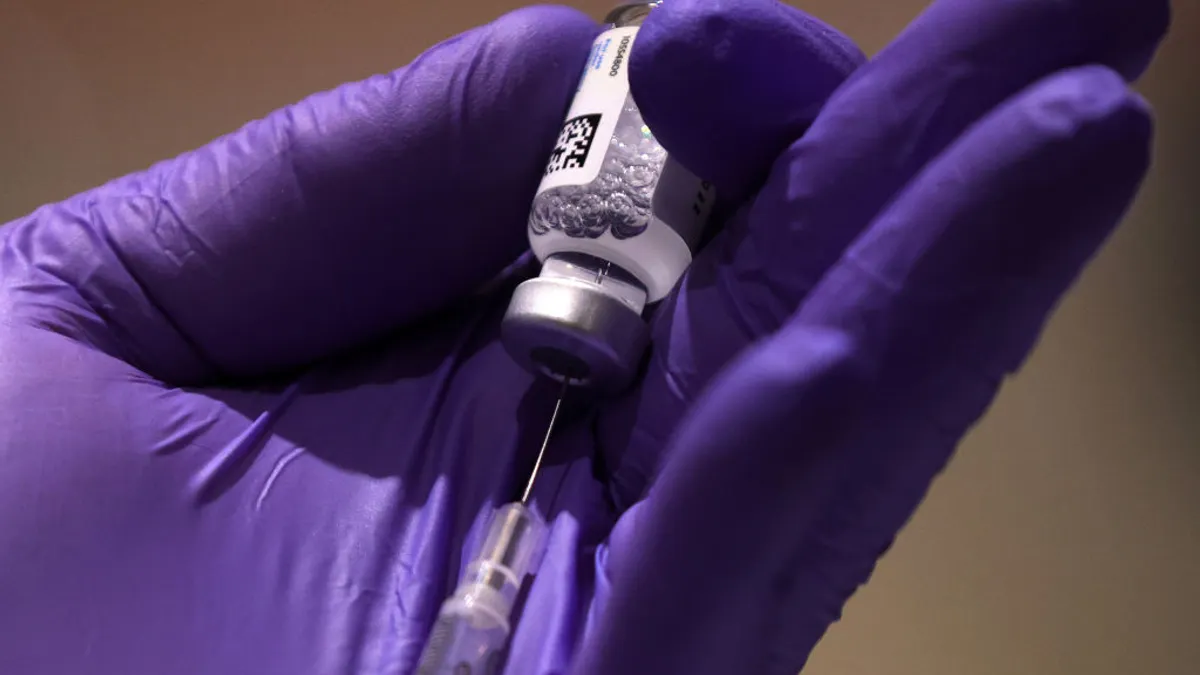For pharma, AI has quickly evolved from a fringe technology to a growing mainstay of drug development. The momentum to adopt AI has only gained steam during COVID. Not only are AI-driven collaborations becoming more commonplace, they are becoming more robust.
Earlier this month, for example, Sanofi inked a collaboration deal with Exscientia to develop up to 15 novel small molecules. If all of the milestones are hit, the agreement could be worth up to $5.2 billion.
“There were three large AI deals within the space of about a week to kick off 2022,” Dan Chancellor, the Thought Leadership director at Informa Pharma Intelligence says. “In general, the deal values are ticking up.”
In the context of drug discovery, where pharma’s AI adoption is the most mature, the technology has yet to deliver a “big win” — meaning that no molecules discovered and developed with the help of AI have made it to late-stage clinical testing or been approved. But the industry isn’t waiting for that kind of milestone to get into the AI game.
“In the last few years, every single Big Pharma company has been exposed to these kinds of alliances,” Chancellor says. “[AI vendors] are positioning themselves as a solution to help productivity in R&D and a way to lower the risk of failure through the clinical stages. [So, pharma companies] are trying to assess the capabilities these AI companies can bring and add to their internal R&D efforts.”
Behind the flurry of recent collaborations are factors that have become more intense during COVID. In particular, the industry has been under increased pressure to speed drug development and manufacturing to respond quickly to emerging needs. The isolation brought by the pandemic has also pushed more business operations into the digital realm, where AI is well suited to offer new ways of connecting with physicians and patients.
And it isn’t just Big Pharma that’s embracing AI.
“Smaller companies didn’t think they could afford AI…and it really wasn’t attainable five to seven years ago,” explains Derek Choy, the co-founder and chief operating officer of Aktana, a company that specializes in AI solutions for intelligent customer engagement. “But we’ve had a 50% increase in the number of small- to medium-sized businesses [using our solution].”
With the pressure still on pharma to innovate quickly and to adapt business operations for the digital world, the use-cases for AI are increasing in stride.
The AI expansion
Speeding drug discovery
“There are companies that are using AI algorithms from bench to bedside and there are others that are specialists in a particular step of the R&D process,” Chancellor says, describing the shifting landscape of AI solutions providers.
For many vendors, AI has become one aspect of complex platforms that involve several leading-edge technologies. For, North Carolina-based POLARISqb pairing the tech with quantum computing for drug development is what has set its platform apart.
“POLARIS is using quantum computers, AI, machine learning and cloud computing to design novel molecular drugs. And we’re doing this at scale,” Shahar Keinan, CEO of POLARISqb, says. “That is unprecedented in the industry.”
POLARISqb’s platform is designed to start with large “chemical libraries” of small molecules. Using quantum computing — which harnesses quantum physics to quickly calculate outputs — Keinan says the platform zeros in on a smaller set of specific molecular targets. From there, AI and machine learning are used to assess properties of the molecules including their behavioral characteristics, toxicities and more.
Although AI enhances the platform, Keinan says that quantum computing is what makes it work 10,000 times faster than other solutions on the market. And that speed is crucial in an industry that has shown in the pandemic that it can — and wants — to work faster.
“Quantum computing is an amazing field,” she says. “A lot of people think of it as science fiction, but it’s not — it’s here.”
At the moment, Keinan says that POLARISqb, which closed a round of seed funding earlier this year for $2.1 million, is working with several pharma partners to validate the platform.
And with its own assets in development, POLARISqb also represents an emerging type of pharma company that is part solutions provider and part drug developer. According to Keinan, the company plans to increase its annual output of potential targets over the next few years.
“Next year, we will do 20 targets, the year after that we’ll do 50, and then the year after that, we’ll be making 100 assets per year,” she explains. “And we [are scaling production] through fee-for-service, collaborations and by developing our own assets.”
Enhancing commercialization
For Aktana, there’s no question that pharma has more solidly grasped the potential of AI in the context of COVID.
The company’s Contextual Intelligence 360 solution was designed to provide medical and commercial teams with insights on physician behavior and preferences. In particular, the AI-powered SaaS platform generates data that helps sales reps identify the best physicians to engage with, along with information on which channels they interact with the most. Choy says the solution is also being used by pharma companies to aid multi-country rollouts of new drugs.
“What the AI produces is almost like a personal assistant for sales reps and medical representatives,” Choy says.
The pandemic grounded sales forces for many pharma companies, leading them to more heavily leverage digital solutions. Last year, Choy says the company saw an unprecedented 45% growth in the number of omnichannel actions — an AI-driven approach that helps companies reach customers using multiple contact points with a unified platform.
“The increase is significant because it illustrates that in the last year, pandemic drivers have led to the wider adoption of AI,” Choy says.
Although COVID may have driven the need for more digital technologies, Choy says that this uptick also shows that the readiness for AI in pharma is growing, too.
“I think the pandemic proved that the technology is here and it’s not going anywhere,” Choy says. “I think there’s a recognition in the pharmaceutical industry that we have to lean on it now — it’s not just hype.”
Trends to watch
Going forward, more evolution in AI and the burgeoning market around the technology is on the way.
One area of the market Chancellor has his eye on is with companies like POLARISqb who’ve innovated AI solutions, but are also developing drug assets themselves.
“It’s going to be interesting to see whether these companies actually become bona fide drug companies or if they’re using their own pipelines as a sort of shop window to say, ‘We believe in these tools enough that we’re going to fund our own clinical trials to show that the candidates work,’” he says. “We may end up seeing a bit of deal-making flurry as pharma acquires these companies, not just for their capabilities but perhaps also for the drugs they’ve discovered themselves.”
Meanwhile, the wider adoption of AI is forcing improvements in other realms of digital transformation. According to Keinan, efforts to improve the reproducibility of AI-related studies is fueling the need for better data collection and analysis.
“AI and machine learning are only as good as the data you put into it. So, the industry needs to move towards a more coherent or useful set of collaborations, with definitions of what it means to have a reproducible experiment,” she explains. “And there are industry groups promoting these ideas about how to build a data set, and how to make sure it can be used by other groups.”
She also sees opportunities for AI and machine learning to reduce the costs of clinical trials, which is one of the most expensive phases of drug development.
“What is considered a reasonable drug to develop? If we can use machine learning [to answer that question] and design better clinical trials, we can have smaller patient groups in clinical trials and better outcomes,” she says.
Although AI has come a long way in a short time in pharma, Keinan says that with the wider adoption, continued improvements are expected.
“The more technology we can use, the better the process will become,” she says. “There are a lot of changes and I’m really excited about those changes.”




















